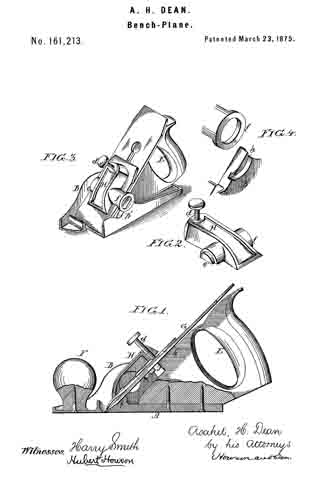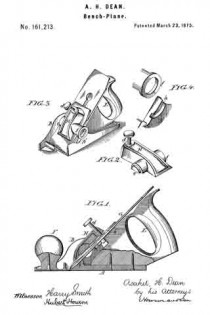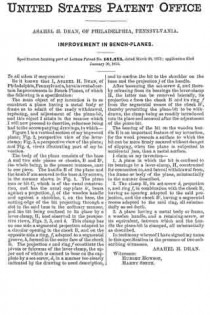No. 161,213 – Improvement In Bench-Planes (Asahel H. Dean) (1875)

UNITED STATES PATENT OFFICE.
_________________
ASAHEL H. DEAN, OF PHILADELPHIA, PENNSYLVANIA.
IMPROVEMENT IN BENCH-PLANES.
_________________
Specification forming part of Letters Patent No. 161,213, dated March 23, 1875; application filed January 30, 1875.
_________________
To all whom it may concern:
Be it known that I, ASAHEL H. DEAN, of Philadelphia, Pennsylvania, have invented certain Improvements in Bench-Planes, of which the following is a specification:
The main object of my invention is to so construct a plane having a metal body or frame as to admit of the ready withdrawal, replacing, and adjustment of the plane-bit, and this object I attain in the manner which I will now proceed to describe, reference being had to the accompanying drawings, in which —
Figure 1 is a vertical section of my improved plane; Fig. 2, perspective view of the lever-clamp; Fig. 3, a perspective view of the plane; and Fig. 4, views illustrating part of my invention.
The body of the plane consists of the base A and two side pieces or cheeks, B and B’, the whole being, in the present instance, cast in one piece. The handle E of the plane and the knob F are secured to the base A by screws, in the manner shown in Fig. 1. The plane iron or bit C, which is of the usual construction, and has the usual cap plate h’, bears against a projection, j, of the wooden handle and against a shoulder, i, on the base, the cutting-edge of the bit projecting through a slot in the said base in the ordinary manner, and the bit being confined to its place by a lever-clamp, H, best observed in the perspective views, Figs. 2, 3, and 4. This clamp has on one side a segmental projection adapted to a circular opening in the cheek B, and on the opposite side a ring, f, adapted to a segmental groove, h, formed in the outer face of the cheek B. The projection e and ring f constitute the pivots or fulcrums of the lever-clamp, the upper end of which is caused to bear on the cap-plate by a set-screw, d, in a manner too clearly indicated by the drawing to need description, and to confine the bit to the shoulder on the base and the projection j of the handle.
After loosening the set~screw d, and thereby releasing from its bearings the lever-clamp H, the latter can be removed laterally, its projection e from the cheek B and its ring f from the segmental recess of the cheek B’, thereby permitting the plane-bit to be withdrawn, the clamp being as readily introduced into its place and secured after the adjustment of the plane-bit.
The bearing of the bit on the wooden handle E is an important feature of my invention, for the wood presents a surface to which the bit can be more firmly secured without danger of slipping, when the plane is subjected to accidental jars, than a metal surface.
I claim as my invention —
I. A plane in which the bit is confined to its bearings by a lever-clamp, H, constructed for connection to, and lateral withdrawal from, the frame or body of the plane, substantially in the manner described.
2. The clamp H, its set-screw d, projection e, and ring f, in combination with the cheek B, having an opening adapted to the said projection, and the cheek B, having a segmental recess adapted to the said ring, all substantially as set forth.
3. A plane having a metal body or frame, a wooden handle, and a retaining-screw, or its equivalent, between which and the handle the plane-bit is clamped, all substantially as described.
In testimony whereof I have signed my name to this specification in the presence of two subscribing witnesses.
ASAHEL H. DEAN.
Witnesses:
HUBERT HOWSON,
HARRY SMITH.


